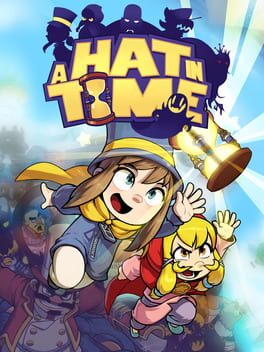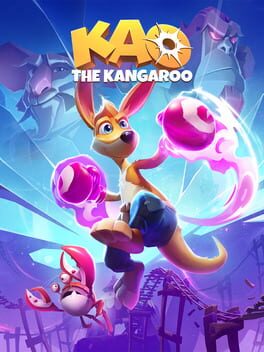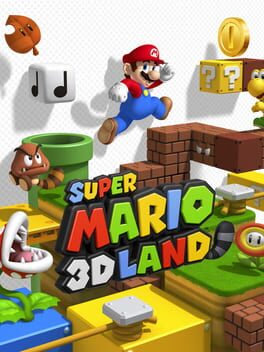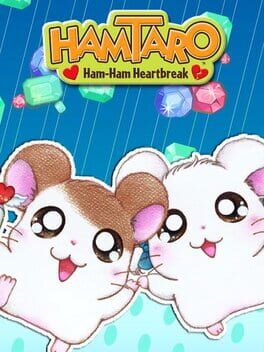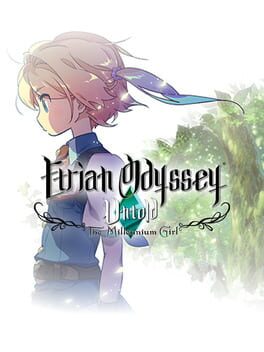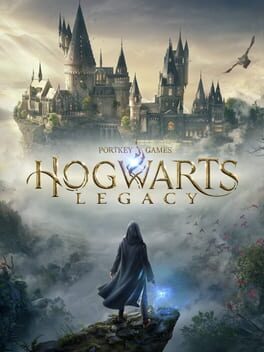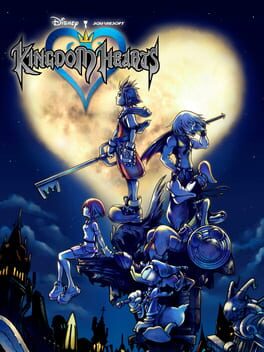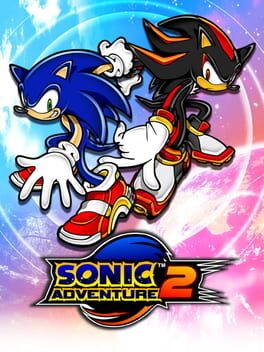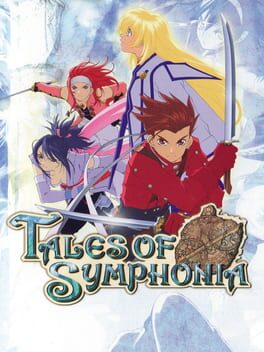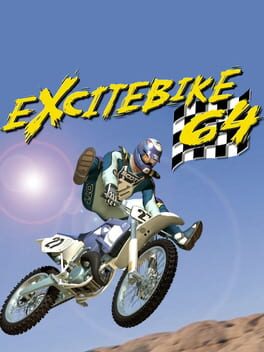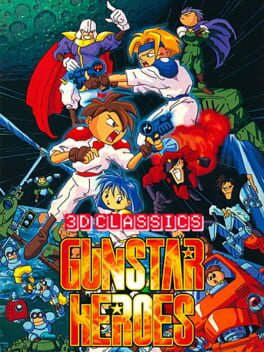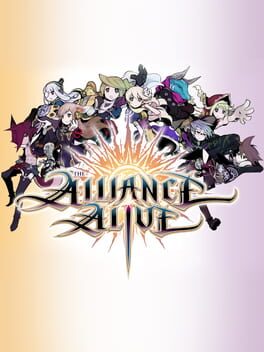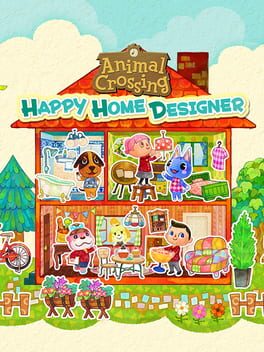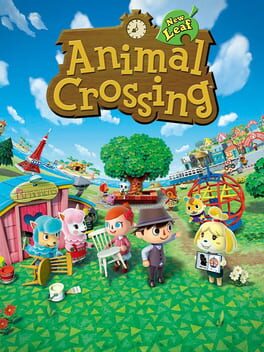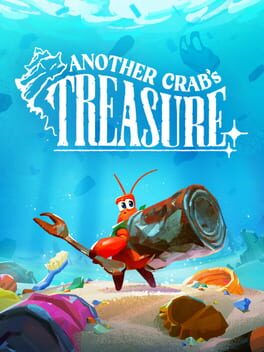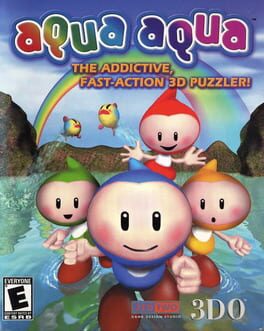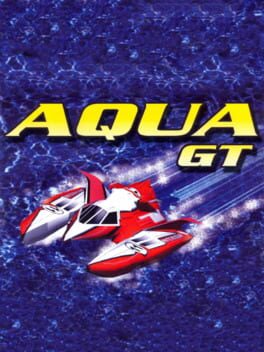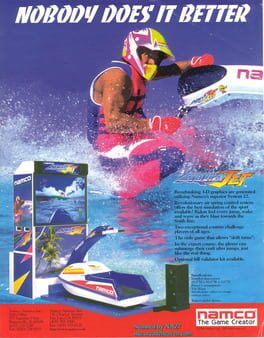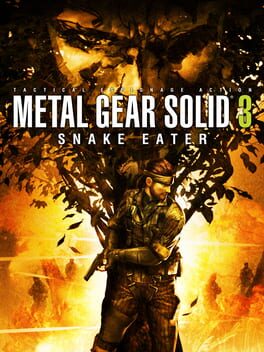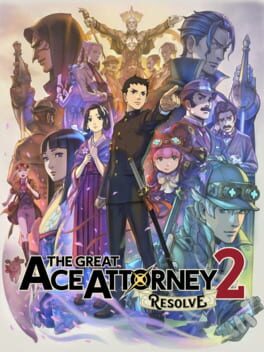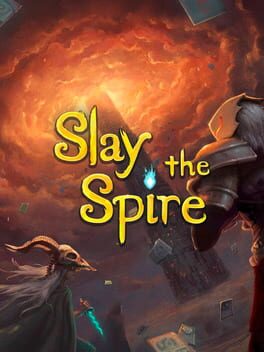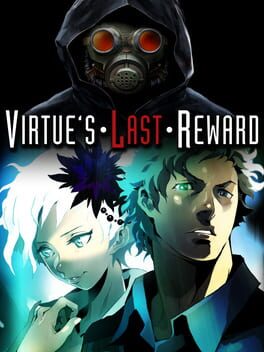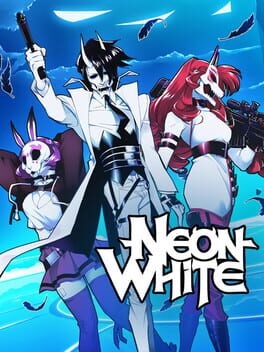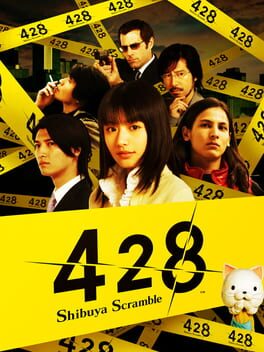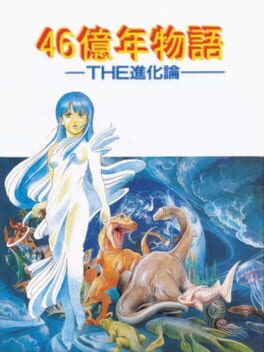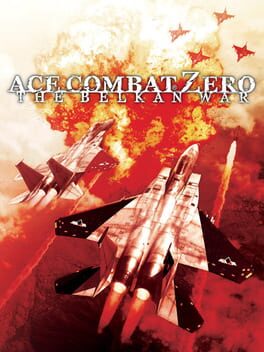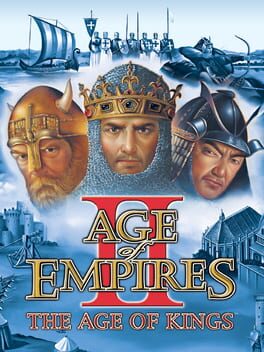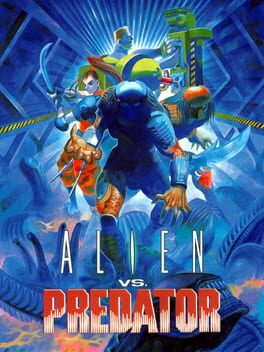hugemouse
23 reviews liked by hugemouse
A Hat in Time
2017
It's a subpar platformer propped up by about a dozen coats of polish. After thinking about it, my main issue is with the game's moveset which, although it may seem to be the opposite at a surface level, is actually pretty restrictive. Let me put it this way. In the air, you have three options: a double jump, a dive, and a flip. However, the flip can only be done directly after a dive, and the double jump can't be done if you've already used a dive. What this means is that if you want to use all of your moves in a single jump, there's only one order you can do them in: double jump -> dive -> flip. This ends up making it so that jumps can't be designed in a way that would require you to use your moves in a different order, leading to just the same set of inputs over and over again for the entire game. What's more inexcusable is the fact that it doesn't even attempt any original mechanics, it's all just so basic. Moving platforms, springs, ropes to swing on, there's nothing new here to figure out. Combine this with the poor moveset and it creates a perfect storm of frustratingly low difficulty. I'd have a hard time believing anyone who has played a 3D platformer before would struggle with any part of this game, and it's not like it even punishes you for dying in the first place. To top it off there's also the badge and yarn systems. Neither of them are well-thought-out at all and their usefulness as collectables ends after about a fifth of the game, which ends up making them feel like huge misses in an understanding of what makes these types of games good.
The counterargument to my thoughts here would be that the game isn't supposed to be a platformer first and foremost and instead an adventure game where the main appeal is reaching varied environments and meeting a unique cast of characters, but I'd disagree with this as well. Something like Psychonauts or Super Mario Galaxy puts the actual platforming in the backseat in favor of interesting experiences, which I'm fine with, but A Hat in Time goes even further and ends up crossing a line. The platforming here feels like a formality, like the sequence of events was thought up first and the platforming is just there to fill in the gaps. Pyschonauts has unique mechanics depending on whose brain you're currently occupying, and Super Mario Galaxy consistently uses its outer space setting to vary up the gameplay. Take away the presentation from A Hat in Time and every world is the exact same, and that's my bottom line. The particle effects, the loading screen art and other 2D assets, the soundtrack, the UI. It's all fantastic but none of it works in service of the goal of creating a good platformer.
The counterargument to my thoughts here would be that the game isn't supposed to be a platformer first and foremost and instead an adventure game where the main appeal is reaching varied environments and meeting a unique cast of characters, but I'd disagree with this as well. Something like Psychonauts or Super Mario Galaxy puts the actual platforming in the backseat in favor of interesting experiences, which I'm fine with, but A Hat in Time goes even further and ends up crossing a line. The platforming here feels like a formality, like the sequence of events was thought up first and the platforming is just there to fill in the gaps. Pyschonauts has unique mechanics depending on whose brain you're currently occupying, and Super Mario Galaxy consistently uses its outer space setting to vary up the gameplay. Take away the presentation from A Hat in Time and every world is the exact same, and that's my bottom line. The particle effects, the loading screen art and other 2D assets, the soundtrack, the UI. It's all fantastic but none of it works in service of the goal of creating a good platformer.
A Hat in Time
2017
Kinda disappointing.
The moveset here for me is the only thing really keeping me from calling this a bad game, it all controls pretty well and feels great.
the game other than that does nothing for me, it's hard to care about any of the characters for me, they don't really change or stick with me to create any sort of emotion, especially in the final boss I wanted to laugh, but they never sort of created that much of a connection. almost all of the guys told me to get lost by the end of their chapters why should I care about them helping me now? why would they do that sort of thing?
My biggest issue is the levels themselves though, they feel big and open, begging to be explored, but the actual missions for the hourglass feel small and linear. Nothing ever motivated me to explore, other than that I should for more hourglasses. Except the Alpine skylines, but that level is so disjointed and TOO big. Chapter 2 was my favorite because it actually benefited from the linear missions and made more small linear areas, it was tons of fun, but that was the only chapter I really enjoyed.
None of the mechanics ever feel to fleshed out either, I only ever felt the need to use 2 badges (the Hookshot and magnet). and the games combat never gets experimental with it or more advanced.
Also I don't like the look of the game that much, I know it tries to have that same charm as the N64/GameCube look but it falls flat for me, I don't like how people's facial features are 2d and floating of their face it doesn't look that appealing.
I hope there's a sequel or another game that this studio makes that can further these mechanics or make them a bit better designed because as is, this game is sort of bleh to me. Good music and controls, but that's it for me.
The moveset here for me is the only thing really keeping me from calling this a bad game, it all controls pretty well and feels great.
the game other than that does nothing for me, it's hard to care about any of the characters for me, they don't really change or stick with me to create any sort of emotion, especially in the final boss I wanted to laugh, but they never sort of created that much of a connection. almost all of the guys told me to get lost by the end of their chapters why should I care about them helping me now? why would they do that sort of thing?
My biggest issue is the levels themselves though, they feel big and open, begging to be explored, but the actual missions for the hourglass feel small and linear. Nothing ever motivated me to explore, other than that I should for more hourglasses. Except the Alpine skylines, but that level is so disjointed and TOO big. Chapter 2 was my favorite because it actually benefited from the linear missions and made more small linear areas, it was tons of fun, but that was the only chapter I really enjoyed.
None of the mechanics ever feel to fleshed out either, I only ever felt the need to use 2 badges (the Hookshot and magnet). and the games combat never gets experimental with it or more advanced.
Also I don't like the look of the game that much, I know it tries to have that same charm as the N64/GameCube look but it falls flat for me, I don't like how people's facial features are 2d and floating of their face it doesn't look that appealing.
I hope there's a sequel or another game that this studio makes that can further these mechanics or make them a bit better designed because as is, this game is sort of bleh to me. Good music and controls, but that's it for me.
Kao the Kangaroo
2022
A fairly decent 3D platformer overall. The graphics are one of the highlights of the game. It looks fairly on par with the recent output from Toys for Bob with similar design ethos and lighting. Kao controls fairly well but the game is really easy and the levels are a bit too straightforward.
Kao the kangaroo lacks any defining feature to make it stand apart from the competition outside of being a reboot of a fairly obscure platforming mascot from Poland. The most it has are elemental powerups that you can imbue in your boxing gloves to solve puzzles, however the elemental powers are one note and never interact together or with the environment in any creative ways. You see a button surrounded by water you hit it with the ice glove, you see a cobweb, you hit it with the fire glove. There's an air glove but it gets so little use and shows up so late that it feels weird to even include at all.
So if it's lacking in originality, it should make up for it with quality, right? Well unfortunately Kao the Kangaroo is one of the least polished games I've played in a while.
Cutscenes are awkward with stiff animation, and the bland but bearable soundtrack will often decide not to trigger, leaving the game with this awkward empty silence. The only things breaking said silence being Kao's footsteps and grunts, because the levels mostly lack any kind of ambience to set the mood outside of the music.
The game features a lot of smashing pots and crates but it felt like half the time they wouldn't shatter into pieces but would instead simply despawn after just sitting there for a second. The world was also unfortunately very transparent, literally. The game opts to use the see through trick to help with camera issues, however a lot of the world becomes semitransparent almost all the time and it really hurts the games aesthetic. It's as distracting as something can be.
I enjoyed my time with the game, but I don't think it stands out among the crowd. Kao himself has some really fun bouncy animation and movement, and if you're really into platformers it's an alright way to spend a dozen hours but I wouldn't reccommend this over many of the other 3D platformers that have come out in recent years, and especially not over the classics that defined the genre.
I got the game on a half off sale and I'd say if you want something very casual and don't mind a little blandness, the Kao reboot is an okay option for that price. I just wish I could give it a better recommendation because there's clearly a lot of talent at Tate Multimedia.
Kao the kangaroo lacks any defining feature to make it stand apart from the competition outside of being a reboot of a fairly obscure platforming mascot from Poland. The most it has are elemental powerups that you can imbue in your boxing gloves to solve puzzles, however the elemental powers are one note and never interact together or with the environment in any creative ways. You see a button surrounded by water you hit it with the ice glove, you see a cobweb, you hit it with the fire glove. There's an air glove but it gets so little use and shows up so late that it feels weird to even include at all.
So if it's lacking in originality, it should make up for it with quality, right? Well unfortunately Kao the Kangaroo is one of the least polished games I've played in a while.
Cutscenes are awkward with stiff animation, and the bland but bearable soundtrack will often decide not to trigger, leaving the game with this awkward empty silence. The only things breaking said silence being Kao's footsteps and grunts, because the levels mostly lack any kind of ambience to set the mood outside of the music.
The game features a lot of smashing pots and crates but it felt like half the time they wouldn't shatter into pieces but would instead simply despawn after just sitting there for a second. The world was also unfortunately very transparent, literally. The game opts to use the see through trick to help with camera issues, however a lot of the world becomes semitransparent almost all the time and it really hurts the games aesthetic. It's as distracting as something can be.
I enjoyed my time with the game, but I don't think it stands out among the crowd. Kao himself has some really fun bouncy animation and movement, and if you're really into platformers it's an alright way to spend a dozen hours but I wouldn't reccommend this over many of the other 3D platformers that have come out in recent years, and especially not over the classics that defined the genre.
I got the game on a half off sale and I'd say if you want something very casual and don't mind a little blandness, the Kao reboot is an okay option for that price. I just wish I could give it a better recommendation because there's clearly a lot of talent at Tate Multimedia.
Kao the Kangaroo
2022
Alright, let’s try this one more time.
Kao the Kangaroo is a reboot of the original mascot 3D platformer series that started in 2000 with its original trilogy. It never sold that well to my knowledge (and having played the original, I think I can more or less make out why), which is why in the wake of the era of the 3D platformer revival, I actually was quite surprised that this got greenlit and announced for release this year. I basically bought the reboot day 1 on Steam back in May, and gave it my best go, but the game was a buggy mess upon release; there were a ton of reports of some users (not all, but enough to where the outcry took up almost all of the Steam Community Forums for the game) suffering from save corruption, where after entering the second world, the game would refuse to save any further progress, meaning that those players would have to beat the game all in one day without any crashes. I called it quits at that time, and wasn’t sure when I’d pick it back up (no chance for a refund, having played more than 2 hours)… well, until today, when my crippling brain disease of wanting to 100% as many games as possible on Steam kicked in. So I ran through the whole thing in a single day, and how does it hold up now?
Honestly, you could take my description of the original game (“an aggressively mediocre mascot 3D platformer”) and put it in the context of the indie 3D platformers of new, and that’s basically this game. You play as the Kao the Kangaroo, hopping around to defeat this evil immortal spirit that has possessed once venerable martial arts masters and turned them into pawns of commercialization and resource exploitation, and find his sister who’s run away from home to find their father who disappeared and since everyone’s kind of incompetent, you’re the only hope that’s left. I’m not going into any further detail than that, as the story’s world building is rather banal and I don’t really think there’s anything memorable of note about any of the characters whatsoever; all you need to know is that you are a kangaroo that can punch things really hard and the big bad are possessing everyone so they can be rich and famous and take over the world and stuff.
You travel around four worlds of mostly linear levels, with a boss in each world as well that you have to beat up so they too can have their own moment where they hold their head in their hands sitting down slumped while going “what have I done????!!!?!!111?!” The original Kao was more or less described by some as a Crash Bandicoot clone, and that’s fortunately not really the case here; there are some divergent paths that will lead to the “KAO” letters as collectibles as well as Eternal Wells that are basically the Time Rifts from A Hat in Time but bad. That's because they’re all really dark and cramped and serve no purpose other than to get a few coins and some diamonds. It’s pretty by the books 3D platforming otherwise; you run down corridors, jump over some gaps and up some cliffs, punch a lot of enemies, run down more hallways, break a lot of crates and barrels for that sweet sweet coin, you get the idea. The two main wrinkles here are that you’ll eventually get elemental powerups for your gloves for environmental interactions (i.e. use the Fire powerup to melt ice and burn spiderwebs) and there are spirit crystals that you can punch to temporarily activate dark crystal platforms.
Now, onto the bad:
-Despite having fixed the save corruption glitch, the game is still very, very bugged and has some pretty poor programming at times; it’s hard to tell which is which. There are the silly glitches of course, like boxes and crates not breaking into pieces when you punch them and then suddenly disappearing, or audio glitches such as when the background music will just stop playing or when no sound effect plays upon picking up a KAO letter. But those are small potatoes compared to the more damaging glitches; for example, there’s still a notable bug in Frosty Canyon where if you use the trampolines at any time (whether to collect coins or to quickly travel to a previous area from a hidden path) the ground slam attack stops working, as in you can input the action and it won’t come out. This softlocks the level because you need the ground slam to freeze water to push blocks along the ice, so as a result this was a level reset for me and cost me about half an hour or so. Similarly, there’s a glitch in the second to last level where a platform was already activated via the fire powerup slam but was stuck in place for some reason, so I couldn’t progress further down the level and had to again reset. And of course, there were multiple instances where I got stuck between several unbreakable objects (or in one case, near the end of the second to last level, phased through the wall of an unbreakable crate in the last room and couldn’t get out) and had to again, reset my level progress. Looks like there’s still a lot of debugging to be done!
-The hitboxes and hurtboxes of objects and enemies are rather wonky; there are a ton of instances where I was standing right in front of a checkpoint pole and punching it for coins/health, where my first two hits would contact the checkpoint pole but the third hit would often completely miss for no apparent reason. This also happens a lot while using the aerial tail spin attack, which would often phase right through enemies despite seemingly contacting their models, or how while mashing the attack button, attacks would randomly miss to the left or right of the models while hits inbetween would land. Also, sometimes enemies fail to disappear on time when their health is fully depleted and will still hit you with lingering attacks/hitboxes despite being downed.
-Combat generally still feels good enough, even with the aforementioned bugs/poor programming, but it’s a bit too mindless. You can just mash the attack button to punch spam your way through, and then hit the slow-mo slam button (not to be confused with the manual aerial ground slam) when your meter has built up enough thanks to enough consecutive hits. Even while taking some hits, there are enough I-frames to where this mindless strategy will beat everything in your path, since the slow-mo slam will take out most enemies near you or stun them long enough to where they’re basically helpless to be punched until they disappear, and you’ll often get hearts from defeating enemies anyways to recover health.
-On that note, this game is pretty damn easy, and not in a good way; you’re incentivized to collect permanent health powerups (collect 4 and gain the ability to take another hit), and the game is constantly throwing extra life collectibles and heart drops in all the levels. You can also punch the checkpoint poles every time you get to a new one to get a heart drop. As a result, I was often at or near full health, and had over 24 extra lives by the end of the game, with maybe only 3 actual in game deaths and I didn’t even need to purchase any extra lives for 500 coins.
-Gems are supposedly the rarer collectible when compared to coins, given how you often need to throw yourself into more danger (i.e. over pits of lava, spike traps, etc) to collect them. But they don’t even do anything! I was never able to find any way to redeem them for rewards (whereas you can at least buy costumes/permanent health upgrades/extra lives with coins), so while there’s a counter tracking how many gems you’ve found per level, they just sit there and exist.
-The grappling hook momentum physics are the absolute worst. When holding onto a grappling hook, you’ll swing back and forth as expected, but sometimes when you let go of the grappling hook at the end of a swing, Kao turns 90 degrees to the left/right and launches in that direction or at times will even launch away from the apex of the swing. So I often had to grab onto the grappling hook again to correct my drift, and that isn’t a surefire solution either because Kao inconsistently turns or will not turn around on a regrab (you can’t rotate the way you’re facing or your direction of swing while hanging onto a grappling hook either) and sometimes may have been propelled far away enough to where a regrab is out of range. This is the only part of the game that I would consider “difficult” because I could not find a consistent way to get off of grappling hooks as I’d like, and would constantly propel into walls or depths; even when I’d say it was doable, I’d often have to correct against the inconsistent drift by tilting the joystick in the other direction, and would barely land on the platform.
-I’ve made fun of the story/worldbuilding/characters already, but the voice acting as part of this package is atrocious. I get not having the budget to hire a localization team to get dedicated voice actors for English or other languages, but the current voice actors sound very inexperienced at best and extremely forced/stilted at worst and will quip a generic NPC dialogue line every minute or so as you progress further through a level. The bland dialogue lines unfortunately made me care even less about what was going on to drive the plot forward.
-There are a bunch of other bugs that I haven’t even addressed which have been found by other users; I’m not sure if these have been fixed since then, but considering that the latest post hasn’t been addressed by the developers, I would suggest you err on the side of caution.
I dunno, I think the reboot is at least a better product and more fun to play than the original Kao the Kangaroo from 2000 (a very low bar, I’m aware), but after 100%ing it myself, I can’t actually think of any reason to recommend this over A Hat in Time or Psychonauts 2. The characters are all boring, the story feels rather inconsequential, the NPCs don’t even change their dialogue after beating the boss in each area or the final boss so your actions feel like they have no impact, I barely felt challenged or engaged despite being the target demographic, there are bugs galore yet not a single danger noodle to be found in the land down under… I could go on and on, but ultimately I think this is one of the 3D platformers of all time, and that is unfortunately the nicest thing I can say about it.
Kao the Kangaroo is a reboot of the original mascot 3D platformer series that started in 2000 with its original trilogy. It never sold that well to my knowledge (and having played the original, I think I can more or less make out why), which is why in the wake of the era of the 3D platformer revival, I actually was quite surprised that this got greenlit and announced for release this year. I basically bought the reboot day 1 on Steam back in May, and gave it my best go, but the game was a buggy mess upon release; there were a ton of reports of some users (not all, but enough to where the outcry took up almost all of the Steam Community Forums for the game) suffering from save corruption, where after entering the second world, the game would refuse to save any further progress, meaning that those players would have to beat the game all in one day without any crashes. I called it quits at that time, and wasn’t sure when I’d pick it back up (no chance for a refund, having played more than 2 hours)… well, until today, when my crippling brain disease of wanting to 100% as many games as possible on Steam kicked in. So I ran through the whole thing in a single day, and how does it hold up now?
Honestly, you could take my description of the original game (“an aggressively mediocre mascot 3D platformer”) and put it in the context of the indie 3D platformers of new, and that’s basically this game. You play as the Kao the Kangaroo, hopping around to defeat this evil immortal spirit that has possessed once venerable martial arts masters and turned them into pawns of commercialization and resource exploitation, and find his sister who’s run away from home to find their father who disappeared and since everyone’s kind of incompetent, you’re the only hope that’s left. I’m not going into any further detail than that, as the story’s world building is rather banal and I don’t really think there’s anything memorable of note about any of the characters whatsoever; all you need to know is that you are a kangaroo that can punch things really hard and the big bad are possessing everyone so they can be rich and famous and take over the world and stuff.
You travel around four worlds of mostly linear levels, with a boss in each world as well that you have to beat up so they too can have their own moment where they hold their head in their hands sitting down slumped while going “what have I done????!!!?!!111?!” The original Kao was more or less described by some as a Crash Bandicoot clone, and that’s fortunately not really the case here; there are some divergent paths that will lead to the “KAO” letters as collectibles as well as Eternal Wells that are basically the Time Rifts from A Hat in Time but bad. That's because they’re all really dark and cramped and serve no purpose other than to get a few coins and some diamonds. It’s pretty by the books 3D platforming otherwise; you run down corridors, jump over some gaps and up some cliffs, punch a lot of enemies, run down more hallways, break a lot of crates and barrels for that sweet sweet coin, you get the idea. The two main wrinkles here are that you’ll eventually get elemental powerups for your gloves for environmental interactions (i.e. use the Fire powerup to melt ice and burn spiderwebs) and there are spirit crystals that you can punch to temporarily activate dark crystal platforms.
Now, onto the bad:
-Despite having fixed the save corruption glitch, the game is still very, very bugged and has some pretty poor programming at times; it’s hard to tell which is which. There are the silly glitches of course, like boxes and crates not breaking into pieces when you punch them and then suddenly disappearing, or audio glitches such as when the background music will just stop playing or when no sound effect plays upon picking up a KAO letter. But those are small potatoes compared to the more damaging glitches; for example, there’s still a notable bug in Frosty Canyon where if you use the trampolines at any time (whether to collect coins or to quickly travel to a previous area from a hidden path) the ground slam attack stops working, as in you can input the action and it won’t come out. This softlocks the level because you need the ground slam to freeze water to push blocks along the ice, so as a result this was a level reset for me and cost me about half an hour or so. Similarly, there’s a glitch in the second to last level where a platform was already activated via the fire powerup slam but was stuck in place for some reason, so I couldn’t progress further down the level and had to again reset. And of course, there were multiple instances where I got stuck between several unbreakable objects (or in one case, near the end of the second to last level, phased through the wall of an unbreakable crate in the last room and couldn’t get out) and had to again, reset my level progress. Looks like there’s still a lot of debugging to be done!
-The hitboxes and hurtboxes of objects and enemies are rather wonky; there are a ton of instances where I was standing right in front of a checkpoint pole and punching it for coins/health, where my first two hits would contact the checkpoint pole but the third hit would often completely miss for no apparent reason. This also happens a lot while using the aerial tail spin attack, which would often phase right through enemies despite seemingly contacting their models, or how while mashing the attack button, attacks would randomly miss to the left or right of the models while hits inbetween would land. Also, sometimes enemies fail to disappear on time when their health is fully depleted and will still hit you with lingering attacks/hitboxes despite being downed.
-Combat generally still feels good enough, even with the aforementioned bugs/poor programming, but it’s a bit too mindless. You can just mash the attack button to punch spam your way through, and then hit the slow-mo slam button (not to be confused with the manual aerial ground slam) when your meter has built up enough thanks to enough consecutive hits. Even while taking some hits, there are enough I-frames to where this mindless strategy will beat everything in your path, since the slow-mo slam will take out most enemies near you or stun them long enough to where they’re basically helpless to be punched until they disappear, and you’ll often get hearts from defeating enemies anyways to recover health.
-On that note, this game is pretty damn easy, and not in a good way; you’re incentivized to collect permanent health powerups (collect 4 and gain the ability to take another hit), and the game is constantly throwing extra life collectibles and heart drops in all the levels. You can also punch the checkpoint poles every time you get to a new one to get a heart drop. As a result, I was often at or near full health, and had over 24 extra lives by the end of the game, with maybe only 3 actual in game deaths and I didn’t even need to purchase any extra lives for 500 coins.
-Gems are supposedly the rarer collectible when compared to coins, given how you often need to throw yourself into more danger (i.e. over pits of lava, spike traps, etc) to collect them. But they don’t even do anything! I was never able to find any way to redeem them for rewards (whereas you can at least buy costumes/permanent health upgrades/extra lives with coins), so while there’s a counter tracking how many gems you’ve found per level, they just sit there and exist.
-The grappling hook momentum physics are the absolute worst. When holding onto a grappling hook, you’ll swing back and forth as expected, but sometimes when you let go of the grappling hook at the end of a swing, Kao turns 90 degrees to the left/right and launches in that direction or at times will even launch away from the apex of the swing. So I often had to grab onto the grappling hook again to correct my drift, and that isn’t a surefire solution either because Kao inconsistently turns or will not turn around on a regrab (you can’t rotate the way you’re facing or your direction of swing while hanging onto a grappling hook either) and sometimes may have been propelled far away enough to where a regrab is out of range. This is the only part of the game that I would consider “difficult” because I could not find a consistent way to get off of grappling hooks as I’d like, and would constantly propel into walls or depths; even when I’d say it was doable, I’d often have to correct against the inconsistent drift by tilting the joystick in the other direction, and would barely land on the platform.
-I’ve made fun of the story/worldbuilding/characters already, but the voice acting as part of this package is atrocious. I get not having the budget to hire a localization team to get dedicated voice actors for English or other languages, but the current voice actors sound very inexperienced at best and extremely forced/stilted at worst and will quip a generic NPC dialogue line every minute or so as you progress further through a level. The bland dialogue lines unfortunately made me care even less about what was going on to drive the plot forward.
-There are a bunch of other bugs that I haven’t even addressed which have been found by other users; I’m not sure if these have been fixed since then, but considering that the latest post hasn’t been addressed by the developers, I would suggest you err on the side of caution.
I dunno, I think the reboot is at least a better product and more fun to play than the original Kao the Kangaroo from 2000 (a very low bar, I’m aware), but after 100%ing it myself, I can’t actually think of any reason to recommend this over A Hat in Time or Psychonauts 2. The characters are all boring, the story feels rather inconsequential, the NPCs don’t even change their dialogue after beating the boss in each area or the final boss so your actions feel like they have no impact, I barely felt challenged or engaged despite being the target demographic, there are bugs galore yet not a single danger noodle to be found in the land down under… I could go on and on, but ultimately I think this is one of the 3D platformers of all time, and that is unfortunately the nicest thing I can say about it.
Super Mario 3D Land
2011
A combat-less RPG focused around talking to hamsters while you play as a pair of hamsters, (concurrently, all the time), doing cute emotes together. With homages to Luigi's Mansion and the Legend of Zelda, there is more depth and variety to be found than the box art might suggest.
Developed by Pax Softnica for the Game Boy Advance, Hamtaro: Ham-Ham Heartbreak closely follows as a mechanical successor to their charming Game Boy Color game, Hamtaro: Ham-Hams Unite!, released a year prior. After Hamtaro: Ham-Ham Heartbreak, future Hamtaro games were developed by Alpha Dream, and a year later following this game's release, Alpha Dream released Mario and Luigi: Super Star Saga, also for the Game Boy Advance. That's right, the "control two protagonists" gimmick that sustained the Mario and Luigi franchise was inspired directly by Hamtaro: Ham-Ham Heartbreak.
As a successor to Unite, Heartbreak has many balance and quality of life changes that make for a smoother gameplay experience. The hint system has become more robust, costs for story relevant item purchases have been reduced, and currency acquisition has been boosted. (Most important to me is the reduction in grifters - Unite was fierce in how many hamsters were out to scam you out of your hard earned sunflower seeds!)
The central gimmick of controlling two hamsters at once gives the game a unique and wholesome feel unlike anything I've played. Most game actions are performed as a duo, but their reactions to situations are still unique. For example, you'll need to balance on each other's shoulders for reaching high places, or pull together to open heavy doors. But there are plenty of small touches that show their individuality. The male hamster gets scared on rollercoasters the girl hamster finds delightful. The degree to which you see the pair as a unit is enough to make you feel naked in the rare occasions they get separated, beyond the loss of actions that can only be performed as a duo.
The gameplay loop involves a brat hamster with a pitchfork causing G-rated mischief and throwing otherwise loving relationships into strife. Your hamster duo must use the power of communication to clear up misunderstandings and set things right. The more couples you help, the more your vocabulary grows, and the more actions you can perform and hamsters you can help. I appreciate that the game shows romantic, family, and friendship types of love in equal amounts in your quest, and even throws in a kiss between himbos. Gay representation in a Japanese 2002 children's game? No idea how this was made!
While Unite is fairly grounded in its middle school neighborhood setting, with levels based on shrines and libraries, Heartbreak is more fantastical than I expected. This game has a direct antagonist with shapeshifting powers, and the levels of amusement parks and spooky mansions have robots, ghosts, and drag queens. The final level has you sieging a moated castle with the power of a magical spoon, stuck in a pedestal Legend of Zelda style, which can only be claimed by collecting the three colored marbles. (These games were published by Nintendo.)
In my rating system, 2 stars represents an average game, and I award Hamtaro: Ham-Ham Heartbreak 3 stars as a solid B rank game. As a children's game, this is a wonderful introduction to the medium, showcasing charm and variety in an approachable way that invites the player to discover its secrets.
Developed by Pax Softnica for the Game Boy Advance, Hamtaro: Ham-Ham Heartbreak closely follows as a mechanical successor to their charming Game Boy Color game, Hamtaro: Ham-Hams Unite!, released a year prior. After Hamtaro: Ham-Ham Heartbreak, future Hamtaro games were developed by Alpha Dream, and a year later following this game's release, Alpha Dream released Mario and Luigi: Super Star Saga, also for the Game Boy Advance. That's right, the "control two protagonists" gimmick that sustained the Mario and Luigi franchise was inspired directly by Hamtaro: Ham-Ham Heartbreak.
As a successor to Unite, Heartbreak has many balance and quality of life changes that make for a smoother gameplay experience. The hint system has become more robust, costs for story relevant item purchases have been reduced, and currency acquisition has been boosted. (Most important to me is the reduction in grifters - Unite was fierce in how many hamsters were out to scam you out of your hard earned sunflower seeds!)
The central gimmick of controlling two hamsters at once gives the game a unique and wholesome feel unlike anything I've played. Most game actions are performed as a duo, but their reactions to situations are still unique. For example, you'll need to balance on each other's shoulders for reaching high places, or pull together to open heavy doors. But there are plenty of small touches that show their individuality. The male hamster gets scared on rollercoasters the girl hamster finds delightful. The degree to which you see the pair as a unit is enough to make you feel naked in the rare occasions they get separated, beyond the loss of actions that can only be performed as a duo.
The gameplay loop involves a brat hamster with a pitchfork causing G-rated mischief and throwing otherwise loving relationships into strife. Your hamster duo must use the power of communication to clear up misunderstandings and set things right. The more couples you help, the more your vocabulary grows, and the more actions you can perform and hamsters you can help. I appreciate that the game shows romantic, family, and friendship types of love in equal amounts in your quest, and even throws in a kiss between himbos. Gay representation in a Japanese 2002 children's game? No idea how this was made!
While Unite is fairly grounded in its middle school neighborhood setting, with levels based on shrines and libraries, Heartbreak is more fantastical than I expected. This game has a direct antagonist with shapeshifting powers, and the levels of amusement parks and spooky mansions have robots, ghosts, and drag queens. The final level has you sieging a moated castle with the power of a magical spoon, stuck in a pedestal Legend of Zelda style, which can only be claimed by collecting the three colored marbles. (These games were published by Nintendo.)
In my rating system, 2 stars represents an average game, and I award Hamtaro: Ham-Ham Heartbreak 3 stars as a solid B rank game. As a children's game, this is a wonderful introduction to the medium, showcasing charm and variety in an approachable way that invites the player to discover its secrets.
Splatoon 3
2022
Ay! (This is the worst one.)
I cannot comprehend adding all of the trappings of free-to-play always-online microtransaction bullshit and not even having microtransactions. Don't get me wrong, I hate microtransactions! (I think they should be illegal, if defining them in an enforceable way was at all possible!) But do not mistake that as praise for Splatoon 3 having the trappings without a connection to the real-world economy. The design philosophy is still there, and it sucks.
And it sucks because it dovetails as an extension of a bad design decision of the very first game, born out of the insecurity of a new IP. In the Splatoon series, you wear three pieces of clothing, each with a main ability and three sub abilities. Main abilities are locked, sub abilities are malleable. Splatoon 1, being light on launch content and not having much incentive for people to play, made unlocking sub abilities completely random. Don't like the three sub-abilities on your favorite pair of shoes? Pay in-game currency for the opportunity to grind out another chance to re-roll for something better. The in-game currency cost for doing so was expensive enough this took hours, and the chances of getting three desired abilities hovered at around 2.7%, creating an amateurish pretense of a grind.
Then Splatoon became wildly successful, earning a sequel. In Splatoon 2, this system should have been thrown out. The demand was out there for this gameplay, with fans pouring hundreds of hours into these titles beyond the point where there was anything for them to conceivably be earning except the thrill of another match.
And yet it stayed. In Splatoon 2, they added a mechanic where earned, undesired sub-abilities could be banked. Banked abilities could be intentionally put on other pieces of clothing later, at a terrible rate of return. Compared to the complete, uncontrollable randomness of Splatoon 1, fans loved this change. And yes, it was better. But the underlying concept was still pointless, time-wasting garbage.
Splatoon 2 was iterative enough that it felt like what could have been a massive update patch on a non-Nintendo platform. It refined gameplay mechanics, added new game modes, and had an art direction both fresh and marketable. For what it was and accomplished, I absolutely loved it upon release. However, Splatoon 3 reveals the poison that is repetition creating tradition.
Because let me be very clear: there is nothing about the concept of Splatoon that should have anything to do with random chance. I believe that for an online multiplayer game, having random chance at all tied to a player's competitive capabilities is downright immoral. There are a million ways to include a grind in a game with cosmetics without resorting to random chance. Using random chance for anything in a video game, (which is always a choice), is either a lazy solution to a complex problem, willfully ignorant, or outright malicious.
If it sounds like I'm going in hard, I am, because gambling is evil. I will rally against gambling anywhere being normalized in any form, because it is a purely human invention for the express purpose of hacking the brains of other vulnerable humans. If you think gambling is fun and harmless, you are the kind of person it does not pose a danger to. Bottom line, anyone's harmless fun is not worth the existence of this kind of evil becoming pervasive enough to reach the people it can harm.
This all comes to bear in Splatoon 3's religious obsession with cramming as much random-ass bullshit into every orifice possible, inventing new orifices for the occassion. The first two games already had clothing rotate daily through three different in-game stores, but now we also have gacha machines for:
+ Gamer tags, complete with titles and background cards!
+ A locker with pointless cosmetic trinkets and its own new rotating daily store!
+ An ENTIRE FUCKING CARD GAME???? WITH BLIND BOOSTER PACKS??????
This is on top of the Splatoon 3 app on your real world phone having rotating selections of gear with unique abilities not found in-game!
And don't worry, the terrible sub-ability system from Splatoon 2 returns, this time bolstered by the gacha machine, the random rewards from Salmon Run, and the real-world time-limited (but free!) seasonal battle pass (here branded as a ~Catalog~).
I pull my hair and gnash my teeth at how many work hours went into creating all of these stupid systems, the required graphics and coding and fine-tuning of probabilities, when as a concept, this makes Splatoon a worse game.
Splatoon has so many weapons catered to many playstyles that increase exponentially once abilities and sub-abilities are in the mix. But the cost to experimenting with ability and sub-ability combinations is far too high, because it is tied to chance. This means willingness to try new weapons and new approaches with existing weapons becomes dependent on one's existing equipment.
And there's no reason for it to be this way anymore! What purpose is it serving??? There are now two games proving that people will play this game longer than Mario Kart. Mario Kart 8 Deluxe had every character unlocked from the start! If you wanted to keep a grind, let me have multiple copies of my favorite shirt, and let me grind to put different abilities on them. Let me grind to give one blue trim or something.
I'm mad because the gameplay is still solid. Salmon Run is better. Overall, objectively, this is the fullest product any Splatoon game has launched in the series.
I'm mad because the underlying theme to all of my complaints can be summed up as: derivative.
Splatoon 1 had several elements I outright hated baked into many of its strengths. The single-player campaign showed how much potential the movement system had for other types of gameplay outside of multiplayer, populated with enemy character designs reminiscent of a trash-tier cancelled Nickelodeon cartoon circa 1997. Splatoon 2 was on such a tight turn-around time frame I could begrudingly forgive their reappearance. But now 3 Splatoons deep, they are part of the series's identity, ugly and permanent.
And now, with the rise of forces outside of Nintendo's sphere of influence, the Fortnite-ification of Splatoon has been baked into the series' identity as well. Grinding for gacha rolls is now the remembered Splatoon 1+2 experience. Adding more meters to fill, more trinkets to roll for, more opportunities to get tokens for currencies for collectibles - it just fits, doesn't it?
I can't play this! I just want to Salmon Run with my friends and get owned in ranked! But the mere existence of all this nonsense seeps into my play experience. There is so much external validation shoved in my face after every match, so much Excel spreadsheet-worthy trinket tracking to occupy my thinking between matches, that I can't hold onto why I would be playing this game for myself, for its own sake.
Which is the ironic tragedy of the series, because at the time of Splatoon 1's release, that was exactly why it felt fresh and subversive. It was tailor made to be baby's first online shooter, free from the decades of garbage that had amassed around the genre. Hell, can you believe that when Splatoon came out, having any color at all was subversive for a shooter? I haven't and will never play Fortnite, but even I know color is now beyond mainstream, it is the riverbed.
Splatoon 3 had a real chance to be something else. Because in the time between Splatoon and Splatoon 3, the online shooter evolved in crazy, unexpected ways, amassing new heaps of new types of garbage. And at its gameplay core, Splatoon is simple and compelling enough to ignore all of it. But instead of focusing on those strengths, Splatoon 3 let some of that garbage seep in.
I can't score this. What do I score?
The gameplay? It's Splatoon 2, but with a couple new shit weapons. It's good, bordering on excellent! Still plays well, still has Nintendo quality internet infrastructure.
The art? The music is already starting to wrap back around to nostalgic licks from the first game, becoming derivative in a corporation's view of rebellion. The visual theming has an identity without being enticing. And the new band of idols wouldn't have placed in a "design a new Splatoon band!" contest on deviantART. When I saw Big Man, I thought I was being punked.
My undying hatred for the dystopian dispassion of Nintendo blindly copying the form of other malicious actors in the video gaming sphere without understanding what the fuck they are doing? Normally that only knocks a game down a star or two, but this time, it feels different.
Outside of the stellar launch year of 2017, Nintendo's major Switch releases have been making me uneasy. Fire Emblem: Three Houses, Animal Crossing: New Horizons, Kirby and the Forgotten Land - they're chock-filled with video game nonsense without purpose in series that didn't used to be that way. But Splatoon is the first franchise in a genre that is not just adjacent to the worst parts of the game industry, it is the worst parts of the game industry. And Splatoon 3 shows that it is not above picking up what the industry is throwing down.
I can't say that it's fine. I also can't say that the game is 'bad'. But I cannot recommend it as a game that is "good." Because the only true test for a work of art's worth is how it makes you feel. And Splatoon 3 made me feel sad, tired, and exhausted, but like I was wrong for feeling so.
Except for Big Man. I fucking hate him so much.
I cannot comprehend adding all of the trappings of free-to-play always-online microtransaction bullshit and not even having microtransactions. Don't get me wrong, I hate microtransactions! (I think they should be illegal, if defining them in an enforceable way was at all possible!) But do not mistake that as praise for Splatoon 3 having the trappings without a connection to the real-world economy. The design philosophy is still there, and it sucks.
And it sucks because it dovetails as an extension of a bad design decision of the very first game, born out of the insecurity of a new IP. In the Splatoon series, you wear three pieces of clothing, each with a main ability and three sub abilities. Main abilities are locked, sub abilities are malleable. Splatoon 1, being light on launch content and not having much incentive for people to play, made unlocking sub abilities completely random. Don't like the three sub-abilities on your favorite pair of shoes? Pay in-game currency for the opportunity to grind out another chance to re-roll for something better. The in-game currency cost for doing so was expensive enough this took hours, and the chances of getting three desired abilities hovered at around 2.7%, creating an amateurish pretense of a grind.
Then Splatoon became wildly successful, earning a sequel. In Splatoon 2, this system should have been thrown out. The demand was out there for this gameplay, with fans pouring hundreds of hours into these titles beyond the point where there was anything for them to conceivably be earning except the thrill of another match.
And yet it stayed. In Splatoon 2, they added a mechanic where earned, undesired sub-abilities could be banked. Banked abilities could be intentionally put on other pieces of clothing later, at a terrible rate of return. Compared to the complete, uncontrollable randomness of Splatoon 1, fans loved this change. And yes, it was better. But the underlying concept was still pointless, time-wasting garbage.
Splatoon 2 was iterative enough that it felt like what could have been a massive update patch on a non-Nintendo platform. It refined gameplay mechanics, added new game modes, and had an art direction both fresh and marketable. For what it was and accomplished, I absolutely loved it upon release. However, Splatoon 3 reveals the poison that is repetition creating tradition.
Because let me be very clear: there is nothing about the concept of Splatoon that should have anything to do with random chance. I believe that for an online multiplayer game, having random chance at all tied to a player's competitive capabilities is downright immoral. There are a million ways to include a grind in a game with cosmetics without resorting to random chance. Using random chance for anything in a video game, (which is always a choice), is either a lazy solution to a complex problem, willfully ignorant, or outright malicious.
If it sounds like I'm going in hard, I am, because gambling is evil. I will rally against gambling anywhere being normalized in any form, because it is a purely human invention for the express purpose of hacking the brains of other vulnerable humans. If you think gambling is fun and harmless, you are the kind of person it does not pose a danger to. Bottom line, anyone's harmless fun is not worth the existence of this kind of evil becoming pervasive enough to reach the people it can harm.
This all comes to bear in Splatoon 3's religious obsession with cramming as much random-ass bullshit into every orifice possible, inventing new orifices for the occassion. The first two games already had clothing rotate daily through three different in-game stores, but now we also have gacha machines for:
+ Gamer tags, complete with titles and background cards!
+ A locker with pointless cosmetic trinkets and its own new rotating daily store!
+ An ENTIRE FUCKING CARD GAME???? WITH BLIND BOOSTER PACKS??????
This is on top of the Splatoon 3 app on your real world phone having rotating selections of gear with unique abilities not found in-game!
And don't worry, the terrible sub-ability system from Splatoon 2 returns, this time bolstered by the gacha machine, the random rewards from Salmon Run, and the real-world time-limited (but free!) seasonal battle pass (here branded as a ~Catalog~).
I pull my hair and gnash my teeth at how many work hours went into creating all of these stupid systems, the required graphics and coding and fine-tuning of probabilities, when as a concept, this makes Splatoon a worse game.
Splatoon has so many weapons catered to many playstyles that increase exponentially once abilities and sub-abilities are in the mix. But the cost to experimenting with ability and sub-ability combinations is far too high, because it is tied to chance. This means willingness to try new weapons and new approaches with existing weapons becomes dependent on one's existing equipment.
And there's no reason for it to be this way anymore! What purpose is it serving??? There are now two games proving that people will play this game longer than Mario Kart. Mario Kart 8 Deluxe had every character unlocked from the start! If you wanted to keep a grind, let me have multiple copies of my favorite shirt, and let me grind to put different abilities on them. Let me grind to give one blue trim or something.
I'm mad because the gameplay is still solid. Salmon Run is better. Overall, objectively, this is the fullest product any Splatoon game has launched in the series.
I'm mad because the underlying theme to all of my complaints can be summed up as: derivative.
Splatoon 1 had several elements I outright hated baked into many of its strengths. The single-player campaign showed how much potential the movement system had for other types of gameplay outside of multiplayer, populated with enemy character designs reminiscent of a trash-tier cancelled Nickelodeon cartoon circa 1997. Splatoon 2 was on such a tight turn-around time frame I could begrudingly forgive their reappearance. But now 3 Splatoons deep, they are part of the series's identity, ugly and permanent.
And now, with the rise of forces outside of Nintendo's sphere of influence, the Fortnite-ification of Splatoon has been baked into the series' identity as well. Grinding for gacha rolls is now the remembered Splatoon 1+2 experience. Adding more meters to fill, more trinkets to roll for, more opportunities to get tokens for currencies for collectibles - it just fits, doesn't it?
I can't play this! I just want to Salmon Run with my friends and get owned in ranked! But the mere existence of all this nonsense seeps into my play experience. There is so much external validation shoved in my face after every match, so much Excel spreadsheet-worthy trinket tracking to occupy my thinking between matches, that I can't hold onto why I would be playing this game for myself, for its own sake.
Which is the ironic tragedy of the series, because at the time of Splatoon 1's release, that was exactly why it felt fresh and subversive. It was tailor made to be baby's first online shooter, free from the decades of garbage that had amassed around the genre. Hell, can you believe that when Splatoon came out, having any color at all was subversive for a shooter? I haven't and will never play Fortnite, but even I know color is now beyond mainstream, it is the riverbed.
Splatoon 3 had a real chance to be something else. Because in the time between Splatoon and Splatoon 3, the online shooter evolved in crazy, unexpected ways, amassing new heaps of new types of garbage. And at its gameplay core, Splatoon is simple and compelling enough to ignore all of it. But instead of focusing on those strengths, Splatoon 3 let some of that garbage seep in.
I can't score this. What do I score?
The gameplay? It's Splatoon 2, but with a couple new shit weapons. It's good, bordering on excellent! Still plays well, still has Nintendo quality internet infrastructure.
The art? The music is already starting to wrap back around to nostalgic licks from the first game, becoming derivative in a corporation's view of rebellion. The visual theming has an identity without being enticing. And the new band of idols wouldn't have placed in a "design a new Splatoon band!" contest on deviantART. When I saw Big Man, I thought I was being punked.
My undying hatred for the dystopian dispassion of Nintendo blindly copying the form of other malicious actors in the video gaming sphere without understanding what the fuck they are doing? Normally that only knocks a game down a star or two, but this time, it feels different.
Outside of the stellar launch year of 2017, Nintendo's major Switch releases have been making me uneasy. Fire Emblem: Three Houses, Animal Crossing: New Horizons, Kirby and the Forgotten Land - they're chock-filled with video game nonsense without purpose in series that didn't used to be that way. But Splatoon is the first franchise in a genre that is not just adjacent to the worst parts of the game industry, it is the worst parts of the game industry. And Splatoon 3 shows that it is not above picking up what the industry is throwing down.
I can't say that it's fine. I also can't say that the game is 'bad'. But I cannot recommend it as a game that is "good." Because the only true test for a work of art's worth is how it makes you feel. And Splatoon 3 made me feel sad, tired, and exhausted, but like I was wrong for feeling so.
Except for Big Man. I fucking hate him so much.
Fallout: New Vegas
2010
2012.
Imagine a young preteen boy living out what was one of the worst years of his life. Puberty was settling upon him, causing massive changes to his body and mind, a torturous calamity the result of aging in the physical sense. This kid was a dumbass clown, never taking the right things seriously, never taking the right things jokingly.
An amoeba of borderline incel like emotions, harboring feelings for every pretty girl he'd lay his eyes on regardless of if their character was good or if he was even being reasonable in his attractions.
During one of the most emotional and terrible times of his life, the man who would eventually become his brother in law got him several Christmas Gifts for the Xbox 360 he had gotten maybe only a year or two prior. There were many games, Gears of War, Batman Arkham City, etc.
But chief among them was Fallout New Vegas.
2009-2010
Jump back a few years to when the boy was younger. He had recently left public school to enter what would be a hellish and depressive 3 year stint as a homeschooler. His half brother had recently returned into his life after mostly being out of the picture. At this point of his life, the boy was losing connection with his social life, becoming an isolated little shrimp who dare not speak to others in complete social fear. Alone, every day in his house, learning propagandist Christian homeschool work. Just him, and his brother, a recovering alcoholic.
One day, the boy and his father go to the basement where the brother lived his days out. He was playing a particular game on his Playstation 3, wearing this Abe Lincoln hat in game and wandering this devastated yet familiar landscape. The brother talked about it being the third entry in the Fallout series, and mentioned that a new game would be coming out called Fallout New Vegas.
2000-2009
The boy is born, his life shaped by his parent's love for old media. His dad really loved old music like Frank Sinatra, and once in a Blue Moon, the boy and his dad would watch an old picture together, something that made the father very happy.
The boy spent a lot of time with his mom in this time, his parents were divorced around his second to third year of existence you see. The boy would visit her work place and her parents frequently, the D.C. area was very familiar to him.
It felt like home.
2009-2010
The boy recognizes the setting of this third Fallout game to be a destroyed version of his home, with music playing that reminded him much of songs his father and him would listen too.
2011
The brother would leave and join the military. The boy never felt so alone before in his entire life.
2012
The boy returns to school, his social awareness crippled by years spent languishing on Youtube alone and being brainwashed by the Christian agenda.
He meets friends he would keep for what is currently the remainder of his life.
Which brings us to Christmas of 2012 once again.
At first the boy was not interested in this Fallout New Vegas, his cousin had ruined first person shooters for him, constantly tearing away his freedom from his own devices in order to play schlock like Modern Warfare 3.
There was a trauma that happened, we won't go into the details, but it severely impacted the boy for the rest of his life, even now.
Fallout New Vegas is what carried him through it.
It's what carried me through the difficult times in my life.
Fallout New Vegas is a game that is so heavily focused on showing both the consequences of your actions while simultaneously telling you to move on from the past and keep living.
Despite its post apocalyptic world, the people of New Vegas are always trying to keep going, with the backing track of songs like Jingle Jangle Jingle being very much about continuing forward through life, while other tracks like Blue Moon and Ain't That a Kick in The Head show the positive consequences that showing affection to another person can bring.
All of these songs brought together by the calm yet caring voice of Mr. New Vegas, who despite not being real in both the game and in real life, comforted me greatly and made me feel like I was wanted. That I belonged somewhere in this twisted awful place in my life.
I spent a lot of time with my companions, one in particular being Craig Boone, the soldier who lost his wife to slavery. Even to this day I sympathize with his character. This is a man who has had to suffer so much pain, even outside of just his wife and unborn child being enslaved and him mercy killing them. He's killed innocent people under orders, despite not wanting too, and at the end of the day he can atone, and be loved.
Many of the companions fit with this central theme of moving on from the past and embracing the choices you make. Veronica, Raul, Cass, Rex, ED-E, Lily, Arcade, and that's not even getting on the DLC companions, all of them have to learn to either move on or accept the past.
I think that's why this game has the draw it has, and honestly why it's so beloved by the transgender community. I'm not going to speak for them honestly, I am a cis male, but I think I understand why they love it so much.
The freedom of being able to carve your own path forward, and leave that past behind, having the choices you make find you a place to belong, I get it.
I think a part of me is very sentimental over this game, despite its various bugs and gameplay issues, but you'll have to forgive me it's almost been 10 years that this game has been in my life.
Fallout New Vegas is very much about making a new chapter in your life, and honestly...
It saved mine.
Imagine a young preteen boy living out what was one of the worst years of his life. Puberty was settling upon him, causing massive changes to his body and mind, a torturous calamity the result of aging in the physical sense. This kid was a dumbass clown, never taking the right things seriously, never taking the right things jokingly.
An amoeba of borderline incel like emotions, harboring feelings for every pretty girl he'd lay his eyes on regardless of if their character was good or if he was even being reasonable in his attractions.
During one of the most emotional and terrible times of his life, the man who would eventually become his brother in law got him several Christmas Gifts for the Xbox 360 he had gotten maybe only a year or two prior. There were many games, Gears of War, Batman Arkham City, etc.
But chief among them was Fallout New Vegas.
2009-2010
Jump back a few years to when the boy was younger. He had recently left public school to enter what would be a hellish and depressive 3 year stint as a homeschooler. His half brother had recently returned into his life after mostly being out of the picture. At this point of his life, the boy was losing connection with his social life, becoming an isolated little shrimp who dare not speak to others in complete social fear. Alone, every day in his house, learning propagandist Christian homeschool work. Just him, and his brother, a recovering alcoholic.
One day, the boy and his father go to the basement where the brother lived his days out. He was playing a particular game on his Playstation 3, wearing this Abe Lincoln hat in game and wandering this devastated yet familiar landscape. The brother talked about it being the third entry in the Fallout series, and mentioned that a new game would be coming out called Fallout New Vegas.
2000-2009
The boy is born, his life shaped by his parent's love for old media. His dad really loved old music like Frank Sinatra, and once in a Blue Moon, the boy and his dad would watch an old picture together, something that made the father very happy.
The boy spent a lot of time with his mom in this time, his parents were divorced around his second to third year of existence you see. The boy would visit her work place and her parents frequently, the D.C. area was very familiar to him.
It felt like home.
2009-2010
The boy recognizes the setting of this third Fallout game to be a destroyed version of his home, with music playing that reminded him much of songs his father and him would listen too.
2011
The brother would leave and join the military. The boy never felt so alone before in his entire life.
2012
The boy returns to school, his social awareness crippled by years spent languishing on Youtube alone and being brainwashed by the Christian agenda.
He meets friends he would keep for what is currently the remainder of his life.
Which brings us to Christmas of 2012 once again.
At first the boy was not interested in this Fallout New Vegas, his cousin had ruined first person shooters for him, constantly tearing away his freedom from his own devices in order to play schlock like Modern Warfare 3.
There was a trauma that happened, we won't go into the details, but it severely impacted the boy for the rest of his life, even now.
Fallout New Vegas is what carried him through it.
It's what carried me through the difficult times in my life.
Fallout New Vegas is a game that is so heavily focused on showing both the consequences of your actions while simultaneously telling you to move on from the past and keep living.
Despite its post apocalyptic world, the people of New Vegas are always trying to keep going, with the backing track of songs like Jingle Jangle Jingle being very much about continuing forward through life, while other tracks like Blue Moon and Ain't That a Kick in The Head show the positive consequences that showing affection to another person can bring.
All of these songs brought together by the calm yet caring voice of Mr. New Vegas, who despite not being real in both the game and in real life, comforted me greatly and made me feel like I was wanted. That I belonged somewhere in this twisted awful place in my life.
I spent a lot of time with my companions, one in particular being Craig Boone, the soldier who lost his wife to slavery. Even to this day I sympathize with his character. This is a man who has had to suffer so much pain, even outside of just his wife and unborn child being enslaved and him mercy killing them. He's killed innocent people under orders, despite not wanting too, and at the end of the day he can atone, and be loved.
Many of the companions fit with this central theme of moving on from the past and embracing the choices you make. Veronica, Raul, Cass, Rex, ED-E, Lily, Arcade, and that's not even getting on the DLC companions, all of them have to learn to either move on or accept the past.
I think that's why this game has the draw it has, and honestly why it's so beloved by the transgender community. I'm not going to speak for them honestly, I am a cis male, but I think I understand why they love it so much.
The freedom of being able to carve your own path forward, and leave that past behind, having the choices you make find you a place to belong, I get it.
I think a part of me is very sentimental over this game, despite its various bugs and gameplay issues, but you'll have to forgive me it's almost been 10 years that this game has been in my life.
Fallout New Vegas is very much about making a new chapter in your life, and honestly...
It saved mine.
So, it's been about a month since I finished playing Etrian Odyssey Untold, and I was initially going to write this review as like a subtweet to a review to the original Etrian Odyssey due to myself thinking said review is spreading misinformation. However, that's not what I want to do and so this will just be a straightforward review, though I will bring up some minor complaints I have with said review regardless.
Of course, Spoiler Warnings for Etrian Odyssey and Etrian Odyssey Untold.
I had first heard about this game when a friend of mine showed me said review for the original Etrian Odyssey. We had a laugh about how ridiculous we thought the review was, but I didn't ultimately get interested in the game until our friend Alan got to talking about it.
That's when my buddy Simon started his playthrough of the original Etrian Odyssey. The game was very intriguing due to it's nature as a dungeon crawler.
Unlike other Dungeon Crawlers I've played that automatically map for you as you go along, Etrian Odyssey requires the player to chart their own maps utilizing the touchscreen of the DS/3DS. This results in an immersive process I can only compare to how people used to play adventure games back when the Internet was far less accessible and players had to rely on drawing out their own maps to track their locations and findings.
And that was only part of the experience. For alongside navigating blind through these labyrinthian halls of forest, were creatures of pure terror and despair.
FOEs, these imposing Orange Orbs, which contained enemies far deadlier than any other, were plentiful throughout the winding paths and gaping corridors. If you want an accurate description of what FOEs are like, imagine Mr. X from the Resident Evil 2 Remake, but there's more than one and they are everywhere.
Watching Simon wander terrified with his Guild was a sight to behold, and while I was thinking of hopping on the original EO, I quickly changed my mind when I heard this.
Etrian Odyssey Untold's soundtrack, with it's pure orchestrated glory convinced me to play that version, and so I did.
I started the greatest of all the Guilds, the Alan Cock Guild. With myself as the Ronin leader, Alan as our Dark Hunter Mascot, Yuiz as our Masterful Medic, Godman as our Triumphing Troubadour, and Simon as our Helpful Hexer, we were sent out into the Yggdrasil Labyrinth to discover its many environments and venture into its very depths.
At the start, it was brutal. We were barely equipped to fight even the weakest of foes, they weren't so much battles as much as they were fights just to survive. The FOEs were the most terrifying, especially given how the remake opts to show what they actually look like, and because of the use of 3D models, could provide the most terrifying of scenarios like with these Boars shaped like Boulders that wake up when you walk in front of them.
I'd argue that Etrian Odyssey is a better horror game than most on the market. Every new FOE, every new Floor Boss is built up too steadily, and makes encountering them for the first time an absolute shock to the core.
Of course, that only made it all the more satisfying when the Alan Cock Guild grew strong enough to kill these ferocious creatures. As we continued to explore, as Forests gave way to Jungles, and Jungles gave way to Coral Reefs, we got ever stronger.
Along the way, we wind up encountering this Forest Girl who clearly does not want us there. Eventually the Radha, the people who we have been working for the entire game, demand that we do one more thing if we seek to venture further into the labyrinth: "Annihilate the Forest Folk".
So, back onto the minor complaints thing. The review that I read that initially introduced me to this game tried to make this argument that this final mission was Atlus saying that Genocide is good and acceptable. It was also at the point that the mission was introduced that they stopped playing the game.
Now, I'm not going to say Genocide isn't bad, or that the game doesn't have you partake in it. However, I do want to point out that at no point does the game actively relish in the actions.
From the very start of the mission, it is made clear how unsettling this demand is. Quinn, the Mission Giver, is clearly upset about the whole ordeal, mentioning how he "wished they would resolve this peacefully" revealing that the Radha Chieftan, Visil, has been acting strange in regards to these demands.
Throughout the entire quest, it is commented on how your guild does not want to do this, and that the whole thing is a setup by Visil to try and get you killed before you discover more about the Yggdrasil Labyrinth.
The game does not try to glorify the act of genocide, and I think claiming that Atlus was attempting to do so here is disingenuous.
Even then, I'd like to posit this argument. Why is it suddenly that when it is specifically the Forest Folk that it is this moral dilemma?
Think about what you and your party do all game.
From the very start you have been invading the habitats of the various creatures you come across, killing leagues of rats and wolves, slaughtering without end and without mercy. To come to this mission and think that your guild is innocent when they've already decimated an entire eco-system is just a bit hypocritical to be quite frank. (Also just want to say, assuming that Explorers are going to automatically be good is kind of naïve given history, most explorers have done terrible shit.)
And even then, by the end of the game you fight back against those who sent you to commit these heinous acts, and foil their plans with the Yggdrasil Tree.
If I had to make an argument about what I think the game is trying to show is that it shows the results of Capitalism on the environment.
You kill, you take in order to gain wealth and fame for your guild. The entire reason the genocide thing is set up to begin with to get your guild killed is to keep the mystery of the labyrinth going so that more explorers seeking the same fame you do will come to Etria.
More Explorers means more business, and you actively see these effects just by how the Shop's wares increase based on the drops you sell. Watching in real time as you becoming richer makes prices go up, and mercantile empires expand.
But at the end, you turn your back on that. You fight Visil in one last duel and strike him down, ending his plans, and eventually revealing the truth to everyone. Capitalism may have been what drove the guild before, but at the end, you fought to stop the cycle of destruction.
I realize that hey, this is probably an entirely subjective perspective on the whole thing... but I think this idea is interesting to me so I'm sticking with it.
The game is hard, but from the map-making, to the incredible score, to the deeper themes, to the areas themselves being absolutely beautiful, I think it is worth your time.
Also people who think this is boring haven't played enough DMC2.
Anyways this review is probably real messy but I don't think there was much of an overly coherent way of making this. Next review will be more organized.
Of course, Spoiler Warnings for Etrian Odyssey and Etrian Odyssey Untold.
I had first heard about this game when a friend of mine showed me said review for the original Etrian Odyssey. We had a laugh about how ridiculous we thought the review was, but I didn't ultimately get interested in the game until our friend Alan got to talking about it.
That's when my buddy Simon started his playthrough of the original Etrian Odyssey. The game was very intriguing due to it's nature as a dungeon crawler.
Unlike other Dungeon Crawlers I've played that automatically map for you as you go along, Etrian Odyssey requires the player to chart their own maps utilizing the touchscreen of the DS/3DS. This results in an immersive process I can only compare to how people used to play adventure games back when the Internet was far less accessible and players had to rely on drawing out their own maps to track their locations and findings.
And that was only part of the experience. For alongside navigating blind through these labyrinthian halls of forest, were creatures of pure terror and despair.
FOEs, these imposing Orange Orbs, which contained enemies far deadlier than any other, were plentiful throughout the winding paths and gaping corridors. If you want an accurate description of what FOEs are like, imagine Mr. X from the Resident Evil 2 Remake, but there's more than one and they are everywhere.
Watching Simon wander terrified with his Guild was a sight to behold, and while I was thinking of hopping on the original EO, I quickly changed my mind when I heard this.
Etrian Odyssey Untold's soundtrack, with it's pure orchestrated glory convinced me to play that version, and so I did.
I started the greatest of all the Guilds, the Alan Cock Guild. With myself as the Ronin leader, Alan as our Dark Hunter Mascot, Yuiz as our Masterful Medic, Godman as our Triumphing Troubadour, and Simon as our Helpful Hexer, we were sent out into the Yggdrasil Labyrinth to discover its many environments and venture into its very depths.
At the start, it was brutal. We were barely equipped to fight even the weakest of foes, they weren't so much battles as much as they were fights just to survive. The FOEs were the most terrifying, especially given how the remake opts to show what they actually look like, and because of the use of 3D models, could provide the most terrifying of scenarios like with these Boars shaped like Boulders that wake up when you walk in front of them.
I'd argue that Etrian Odyssey is a better horror game than most on the market. Every new FOE, every new Floor Boss is built up too steadily, and makes encountering them for the first time an absolute shock to the core.
Of course, that only made it all the more satisfying when the Alan Cock Guild grew strong enough to kill these ferocious creatures. As we continued to explore, as Forests gave way to Jungles, and Jungles gave way to Coral Reefs, we got ever stronger.
Along the way, we wind up encountering this Forest Girl who clearly does not want us there. Eventually the Radha, the people who we have been working for the entire game, demand that we do one more thing if we seek to venture further into the labyrinth: "Annihilate the Forest Folk".
So, back onto the minor complaints thing. The review that I read that initially introduced me to this game tried to make this argument that this final mission was Atlus saying that Genocide is good and acceptable. It was also at the point that the mission was introduced that they stopped playing the game.
Now, I'm not going to say Genocide isn't bad, or that the game doesn't have you partake in it. However, I do want to point out that at no point does the game actively relish in the actions.
From the very start of the mission, it is made clear how unsettling this demand is. Quinn, the Mission Giver, is clearly upset about the whole ordeal, mentioning how he "wished they would resolve this peacefully" revealing that the Radha Chieftan, Visil, has been acting strange in regards to these demands.
Throughout the entire quest, it is commented on how your guild does not want to do this, and that the whole thing is a setup by Visil to try and get you killed before you discover more about the Yggdrasil Labyrinth.
The game does not try to glorify the act of genocide, and I think claiming that Atlus was attempting to do so here is disingenuous.
Even then, I'd like to posit this argument. Why is it suddenly that when it is specifically the Forest Folk that it is this moral dilemma?
Think about what you and your party do all game.
From the very start you have been invading the habitats of the various creatures you come across, killing leagues of rats and wolves, slaughtering without end and without mercy. To come to this mission and think that your guild is innocent when they've already decimated an entire eco-system is just a bit hypocritical to be quite frank. (Also just want to say, assuming that Explorers are going to automatically be good is kind of naïve given history, most explorers have done terrible shit.)
And even then, by the end of the game you fight back against those who sent you to commit these heinous acts, and foil their plans with the Yggdrasil Tree.
If I had to make an argument about what I think the game is trying to show is that it shows the results of Capitalism on the environment.
You kill, you take in order to gain wealth and fame for your guild. The entire reason the genocide thing is set up to begin with to get your guild killed is to keep the mystery of the labyrinth going so that more explorers seeking the same fame you do will come to Etria.
More Explorers means more business, and you actively see these effects just by how the Shop's wares increase based on the drops you sell. Watching in real time as you becoming richer makes prices go up, and mercantile empires expand.
But at the end, you turn your back on that. You fight Visil in one last duel and strike him down, ending his plans, and eventually revealing the truth to everyone. Capitalism may have been what drove the guild before, but at the end, you fought to stop the cycle of destruction.
I realize that hey, this is probably an entirely subjective perspective on the whole thing... but I think this idea is interesting to me so I'm sticking with it.
The game is hard, but from the map-making, to the incredible score, to the deeper themes, to the areas themselves being absolutely beautiful, I think it is worth your time.
Also people who think this is boring haven't played enough DMC2.
Anyways this review is probably real messy but I don't think there was much of an overly coherent way of making this. Next review will be more organized.
Hogwarts Legacy
2023
This review contains spoilers
Spoiler review so I can dig into why exactly the plot is antisemitic and why you can't "just ignore" it.
The TLDR is that the game's about stopping a goblin rebellion, which we already knew from the trailers. The trailers also included a scene where the main villain goblin and dark wizard talk about kidnapping the player, calling on the antisemitic trope of blood libel.
Well we now have the full context, and it gets so much worse:
The dark wizard Rookwood (no subtleties here as that's the name of one of the Death Eaters in the original series, guess the whole families evil) cursed Anne, the companion characters sister, and framed the goblins for it. This out of context truth is most likely what people will use to say "see the games not antisemitic, the goblins were framed" but this is just backstory for one character and the rest of the game still exist.
While not completely new to the series (offhandedly mentioned like 2 times in the books) this game is the first time anyone learns what exactly "ancient magic" is. Ancient magic is apparently a substance that can be extracted from the body, and apparently extracting it is believed to be a form of "pain relief". Not dissimilar from medieval "therapies" of bloodletting and leeching. The antisemitic blood libel doesn't end with the goblins: In the game's backstory a former Hogwarts professor Isidora Morganach discovered how to tap into "ancient magic" by extracting it from her students. Isidora became addicted to "ancient magic" and made many magic repositories which you can find throughout the game. In the present the player character is someone who has "ancient magic", this is why the goblins and dark wizards want to kidnap you.
The goblins who teamed up with Rookwood are rebelling because the wizards don't give them equal rights, like wand use. As I said in my previous review this along with wizards trying to enslave goblins as "house elves" is already a part of the series' lore for their many rebellions. The game also adds little details like goblin artifacts that are eerily similar to Jewish cultural items, and past rebellions lining up perfectly with real world antisemitic genocides. And of course the final boss of the game is the "evil leader" of the goblin Ronrok who uses all the "ancient magic" to transform into a dragon, as if evil bankers wasn't enough. A better writer would maybe have Rookwood be the final boss after revealing he was just using Ronrok and the goblins plight to his own ends, to marginally make the story better (but not by much). But that wouldn't be in the spirit of the franchise now would it? And like I said in my other review, it's a prequel, they can't actually make any meaningful change to the status of the non-human sapient magical beings without breaking continuity with the original series.
Sure if only one of these were true (and the context of the books and creator didn't exist) it would most likely be an unfortunate (gross) coincidence. But that's not the case.
With Harry Potter you can argue the antisemitism is not a huge part of the books (but still a major issue) but with this game the antisemitism is at the core of its identity. The devs didn't have to quadruple down and add all this, but not surprising that the lead dev was a gamer gater before being booted.
You can't remove this game from its antisemitism and you can't remove this franchise from its creators' bigotry and political views.
Go read "Trans Wizard Harriet Porber And The Bad Boy Parasaurolophus" by Chuck Tingle
The TLDR is that the game's about stopping a goblin rebellion, which we already knew from the trailers. The trailers also included a scene where the main villain goblin and dark wizard talk about kidnapping the player, calling on the antisemitic trope of blood libel.
Well we now have the full context, and it gets so much worse:
The dark wizard Rookwood (no subtleties here as that's the name of one of the Death Eaters in the original series, guess the whole families evil) cursed Anne, the companion characters sister, and framed the goblins for it. This out of context truth is most likely what people will use to say "see the games not antisemitic, the goblins were framed" but this is just backstory for one character and the rest of the game still exist.
While not completely new to the series (offhandedly mentioned like 2 times in the books) this game is the first time anyone learns what exactly "ancient magic" is. Ancient magic is apparently a substance that can be extracted from the body, and apparently extracting it is believed to be a form of "pain relief". Not dissimilar from medieval "therapies" of bloodletting and leeching. The antisemitic blood libel doesn't end with the goblins: In the game's backstory a former Hogwarts professor Isidora Morganach discovered how to tap into "ancient magic" by extracting it from her students. Isidora became addicted to "ancient magic" and made many magic repositories which you can find throughout the game. In the present the player character is someone who has "ancient magic", this is why the goblins and dark wizards want to kidnap you.
The goblins who teamed up with Rookwood are rebelling because the wizards don't give them equal rights, like wand use. As I said in my previous review this along with wizards trying to enslave goblins as "house elves" is already a part of the series' lore for their many rebellions. The game also adds little details like goblin artifacts that are eerily similar to Jewish cultural items, and past rebellions lining up perfectly with real world antisemitic genocides. And of course the final boss of the game is the "evil leader" of the goblin Ronrok who uses all the "ancient magic" to transform into a dragon, as if evil bankers wasn't enough. A better writer would maybe have Rookwood be the final boss after revealing he was just using Ronrok and the goblins plight to his own ends, to marginally make the story better (but not by much). But that wouldn't be in the spirit of the franchise now would it? And like I said in my other review, it's a prequel, they can't actually make any meaningful change to the status of the non-human sapient magical beings without breaking continuity with the original series.
Sure if only one of these were true (and the context of the books and creator didn't exist) it would most likely be an unfortunate (gross) coincidence. But that's not the case.
With Harry Potter you can argue the antisemitism is not a huge part of the books (but still a major issue) but with this game the antisemitism is at the core of its identity. The devs didn't have to quadruple down and add all this, but not surprising that the lead dev was a gamer gater before being booted.
You can't remove this game from its antisemitism and you can't remove this franchise from its creators' bigotry and political views.
Go read "Trans Wizard Harriet Porber And The Bad Boy Parasaurolophus" by Chuck Tingle
6 lists liked by hugemouse
by FrozenRoy |
300 Games
by Bavoom |
128 Games
by DUALSHOCK |
175 Games
by StatisticsMan |
250 Games
by StatisticsMan |
133 Games
by abri |
300 Games
